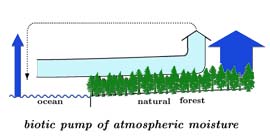You are on the first web site of Biotic Regulation. Since February 14, 2008 it is no longer updated. Welcome to www.bioticregulation.ru! New address of this page: www.bioticregulation.ru/pump/pump.php |
Hot topic: Biotic pump of atmospheric moisture
|
Introduction |
Comments and responses |
|
Biotic regulation of the environment is an
interdisciplinary scientific concept.
During the many years' of its development,
a number of results have been obtained
that we consider important. These are, for example, the demonstration of
the physical instability of the terrestrial climate which, without a
stabilizing biotic impact, would spontaneously degrade to the state of either
boiling or frozen oceans [link], or
our ecological studies demonstrating, among other things, the genetically
encoded human right for a large individual territory of the order of
several square kilometers per person [link]. However, at present these results
either look too global to the lay person to substantiate an appeal for
immediate actions, or they demand an understanding of some relatively
complex scientific realities for their evaluation. Recently, however,
at the interface of the ecological and climatic blocks of
the concept,
we believe to have obtained some scientific results
that can be considered unique in this respect. |
 | ||
|
The main conclusion is clear and transparent: After they are scientifically verified and widely discussed and spread, these findings have the potential of appealing to the majority of people of Earth, because the water problem is of everybody's concern. While in the traditional consideration of the water cycle on land it is assumed that the incoming flux of atmospheric moisture from the ocean is a purely geophysical parameter, i.e. an abiotic constraint on the ecosystem's functioning, we have shown that in reality this flux is fully determined by the properties of the terrestrial vegetation cover, in particular, by the flux of evaporation from its surface. The larger this flux, the stronger the winds from the ocean bringing moisture to land. As far as evaporation is highest above natural forest canopies, large forest-covered continental areas enjoy the largest incoming fluxes of atmospheric moisture. When the forests are being destroyed, these fluxes gradually weaken and cease altogether in deserts, since these are completely deprived of vegetation cover. The-chicken-or-the-egg problem of whether forests grow where it is wet, or it is wet where the forests grow, solves unambiguously in favor of the forests' priority. |
 Due to the high leaf area index, natural forests maintain high transpiration fluxes (thick dark blue arrow), which exceed the evaporation fluxes over the ocean (thin dark blue arrow). Forest transpiration fluxes support the ascending air motion over the forest canopy and "suck in" moist air from the ocean (light blue arrow), which then returns to the ocean in the upper atmosphere (dotted arrow) after precipitation of moisture. | ||
|
The results obtained have originally been published as Preprint No. 2655 of the Petersburg Nuclear Physics Institute, Russian Academy of Sciences. Some preliminary results obtained in collaboration with Professor Bai-Lian Larry Li (University of California, Riverside, USA) have been published in Ecological Research (see abstract). A full and up-to-date description of the biotic pump mechanism can be found in the following publication
O Estado de Sao Paulo, Sao Paulo, Brazil, 8 April 2007 (in Portuguese). Who broke the climate pump? Ye. Kokurina. Moscow News, 19 January 2007 (in Russian).
|
Abstract Full text, screen version (1.0 Mb) Full text, print version (700 Kb) Overview of the results (no math) Comments, questions and responses |
|